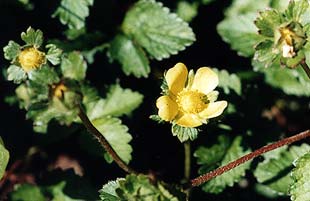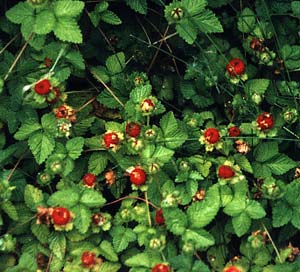 Indian Strawberry
Indian Strawberry
a fruiting creeping groundcover
"There are philosophies as varied as the flowers of the field."
-G. K. Chesterton
(1874-1936)
(1874-1936)
Duchesnea indica, the Indian Strawberry, or Mock Strawberry, loves sun or part shade. As a groundcover, the creeping vines are capable of spreading rampantly & thrive even in harsh conditions, but would prefer moist loamy soil to look their best. They can be a good groundcover under the sorts of rhododendrons or exbury azaleas which need their roots protected from direct sunlight.
Originally from Southeast Asia & the Indies, Indian Strawberry produces beautiful yellow flowers which are their most profuse April through June, but aren't entirely gone until the first frosts in autumn or even later. The very attractive bumply soft round strawberry-like fruit is edible though nearly flavorless. These vines just don't know how to stop producing fruit! The continuous presence of yellow blooms & round red strawberries is quite striking. Though the berries are more decorative than tasty, I'll pop one in my mouth from time to time, & sometimes the birds eat them.
 The vines, flowers, & fruits can appear dainty, but it is a tough & livey plant, requiring little care beyond occasional watering. It can become a nuisance the way vinca can & has naturalized as a weed in South Africa & many other warm regions, including in the American southeast where it has a reputation as a turf-invading pest-plant. Here in the Northwest it does not seem to be quite that difficult to restrain, but probably should not be planted anywhere near shorter plants which it would soon overwhelm.
The vines, flowers, & fruits can appear dainty, but it is a tough & livey plant, requiring little care beyond occasional watering. It can become a nuisance the way vinca can & has naturalized as a weed in South Africa & many other warm regions, including in the American southeast where it has a reputation as a turf-invading pest-plant. Here in the Northwest it does not seem to be quite that difficult to restrain, but probably should not be planted anywhere near shorter plants which it would soon overwhelm.Once when I trimmed it back to get grass out of it, I tossed a few bits of it over the fence to the road's edge, where it unexpectedly rooted & has slowly established itself in a low-maintenance sun-garden, remaining a much thinner groundcover in that dryer area.
It strives to be evergreen or at least semi-evergreen, but winters here are just a little too long, so that a lot of it dies back by late winter. It will send hairy stolons out of gardens across sidewalks or carports, with nodes at intervals which will root even in concrete cracks. Because it can look so healthy & bright at the edges of concrete, it can be nice to line a driveway. It never looks shoddy even if it gets its more exploratory runners run over a bit. And if it is indeed hemmed in between a street &am a sidewalk, it won't so easily become a pest invading next gardens over.